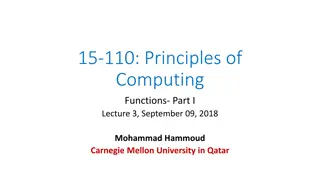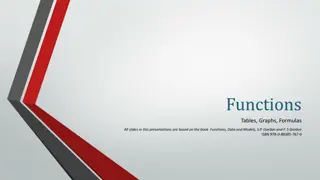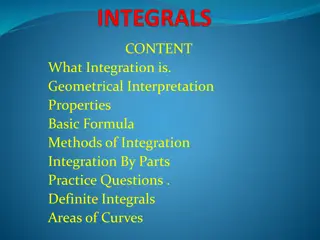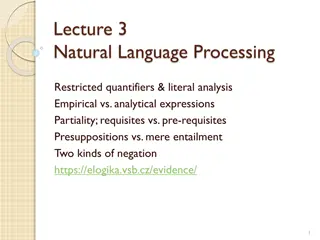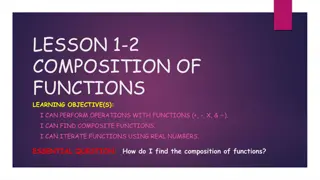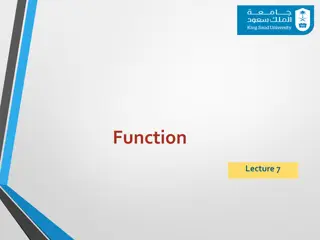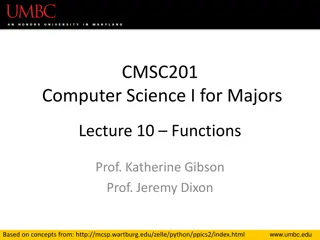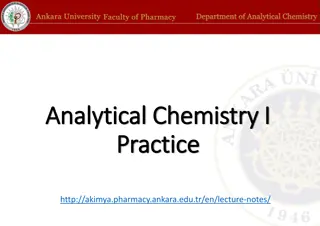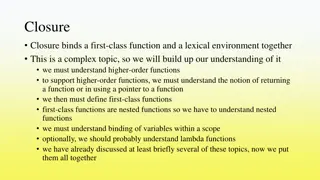Analytical Integration of Functions: A Comprehensive Guide
Functions and their integrals are explored in this guide, covering definitions, simple integration cases, examples, and well-known integrals. Learn about differential equations, inspection integration, and trigonometric functions. Master the techniques with detailed explanations and examples.
Download Presentation

Please find below an Image/Link to download the presentation.
The content on the website is provided AS IS for your information and personal use only. It may not be sold, licensed, or shared on other websites without obtaining consent from the author.If you encounter any issues during the download, it is possible that the publisher has removed the file from their server.
You are allowed to download the files provided on this website for personal or commercial use, subject to the condition that they are used lawfully. All files are the property of their respective owners.
The content on the website is provided AS IS for your information and personal use only. It may not be sold, licensed, or shared on other websites without obtaining consent from the author.
E N D
Presentation Transcript
ANALYTICAL INTEGRATION OF FUNCTIONS Prof. Samuel Okolie, Prof. Yinka Adekunle & Dr. Seun Ebiesuwa
1. A function y = f(x) is called a solution of the differential equation dy/dx = f(x), a <x<b, if over the domain a < x < b F(x) is differentiable and d F(x)/dx = f(x) i.e, F(x) = f(x) dx + c F(x) is an integral of f(x) wrt x, c is a constant of integration. Definition
2. Simple Cases of Integration dx = x + c adx = a dx (dx + dy) = dx + dy xndx = xn+1/ (n+1) + c ; n -1 abf(x) = bxof(x) dx - axof(x) dx = F(b) F(a) where a is a constant
Example: I = u1/2 du/2 where I = u3/2+ c I = (2x+1) dx 2x + 1 = u 2dx = du 3/2 dx = du/2 I = 1/3 u 3/2 + c I = 1/3 (2x + 1) 3/2+ c.
3. Integration by Inspection Some of the simplest functions have well known integrals that should be remembered. The integrals are precisely the converse of the derivatives algebraic functions. i. axndx = axn+1/(n+1) +c ii. eaxdx = eax/ (a) + c iii. a/x dx = alog x + c iv. 1/x dx = log x + c v. a cos bx dx = a sin bx/b + c
vi. a tan bx dx = -a log(cos bx)/b + c vii. a cos bx sin nbx dx = a sinn+1bx / b(n+1) + c viii. a sin bx cosnbx dx = -a cos n+1bx / b(n+1) + c ix. a dx /(a2+ x2) = tan-1(x/a) + c x. -1 dx / ( a2 x2 ) = cos-1(x/a) + c lxl a xi. 1 dx / (a2 x2) = sin-1(x/a) + c xii. dx/x = log lxl + c xiii. axdx = ax/(log a) + c xiv. sec2dx = tan x + c xv. cosec2dx = -cot x + c lxl a Note: d/dx (log x) = 1/x Note: d/dx (ax) = axlog a
xvi. sec x tan x dx = sec x + c xvii. cos x cot x dx = -cosec x + c xviii. sec x dx = log ( sec x + tan x) + c
4. 4.1 I = sinnx dx Case 1 for n = odd, e.g n = 5 I = sin5x dx Rewrite as a product of sin x and an even power of sin x and use the relation Sin2x = 1 cos2x therefore; I = sin4x sin x dx = (1-cos2x)2sin x dx INTEGRATION OF TRIGONOMETRIC FUNCTIONS Integration of Sinusoidal Functions
I = sin4x sin x dx = (1- cos2x)2sin x dx I = ( 1 2 cos2x + cos4x) sin x dx I = (sin x 2 sin x cos2 x + cos4x sin x) dx I = -cos x + cos3x cos5x + c using eqn 3(ix) Case 2 for n = even, eg n = 4 I = sin4x dx Rewrite using double angle formula:
sin2 x = (1-cos 2x) I = ( (1-cos 2x)) 2dx = ( - cos 2x)2dx = ( 2 * * cos 2x + cos22x) dx = ( - cos 2x + cos22x) dx I = x + sin 2x + cos22x dx .* Now cos22x = (1 + cos 4x) I2 = cos22x = ( + cos 4x) dx I2= x/2 + sin 4x **
Substitute ** into * to get: I = x = sin 2x + [x/2 + sin 4x] I = x + sin 2x + x/8 + 1/32 sin 4x 4.2 Integration of cosinusoidal functions 1 = cosn x dx Similar solution can be gotten for integration of powers of cos x for n = odd and even by using the following formula as appropriate. cos 2 x = 1 sin2 x and the double angle formula cos 2 x = (1 + cos 2 x)
5. Integrals for which the integrand may be written as a fraction in which number is the derivation of the denominator may be easily evaluated using the formula Examples: 1/x dx = ln x + c I = (6 x2 + 2 cos x) dx x3 + sin x = 2(3x2 + cos x) x3 + sin x Since the quality in numerator is the derivative of denominator I = 2 ln (x3 + sin x) + c Logarithmic Integration
6. Sometimes a substitution of variables may be made that turns a complicated integral into a simple one which can then be integrated by a standard method. There are many useful substitutions and knowing what to use comes from experience. Example: 1 I = 1/ (1-x2 ) dx Let x = sin u dx = cos u d u I = 1/ 1-sin 2 u (cos u) du = cos u / cos u du = du = u + c = sin-1 x + c Integration by substitution
Example 2 a + b cos x we can make use of the substitution of the form t = tan (x/2) x = 2 tan -1 t dt/dx = sec2 (x/2) = [ 1 + tan2 x/2] = ( 1 + t2) dx = dt 1 + t2 Further since 1 + t2 = sec2 (x/2) I = 1 du or dx a + b sin x
implies cos (x/2) = 1/ (1 + t2) since cos x = 2 cos2 (x/2) -1 cos x = 2 -1 = 1 t2 1 + t2 1 + t2 Example (2 / (1 + 3 cos x) dx 2 [1 + 3 [( 1 t2)(1 + t2) -1 ]] = 2 dt (1 + t2) + 3 ( 1 t2) dt 1 + t2
= (1/(2- t2) dt = dt ( 2 t)( 2 + t) = [(1/ 2 - t) + 1/( 2 + t)] dt = [ln ( 2 t) + ln ( 2 + t)] + c = ln [( 2 t)( 2 + t)] + c = ln [( 2 - tan (x/2))(( 2 + tan (x/2))] + c Integrals of similar form as dx / (a + b cos x ) or dx / (a + b sin x) but involving sin 2x, cos 2x, tan 2x, sin2 x cos 2 x or tan2x instead of sin x and cos 2 x should be evaluated by the substitution t = tan x Hence: sin x = 2t/( 1 + t2 ) ; cos x = 1- t2/(1 + t2)
7. Example 1 = dx / (x2 + 4x + 7) = dx / (x + 2 )2 + 3 Let y = x + 2 I = ( 1/ (y2 + 3) dy = dy / (3 + y2) = 1/ 3 3 dy / (( 3)2 + y2 ) = 3/ 3 tan-1(y/ 3) + c = 3/3 tan -I ( x + 2 / 3) + c. 8. Integration by parts Since d/dx (uv) = u dv/dx + vdu/ dx, v, u are functions of x . uv = u dv/dx dx + du/dx vdx Integration by completing of squares dy = dx
therefore u dv/dx dx = uv - du/dx v dx Integral of a product of two functions, u and dv/dx is { the 1st * integral of the second integral of (derivative of the 1st * integral of the second] In this case the integral of the second must be determinable by inspection Example: x sin x dx u dv/ dx u = x du/dx = 1 dv/dx = sin x, v = cos x I = -x cos x + sin x
Notes: the separation of the functions is not always apparent. Example 1: x3 e-2 dx = x2 (xe-2) dx (2) A trick that is sometimes useful is to take 1 as one factor of the product. eg, I = log x dx = (log x) . l dx. u dv/dx I = log x (x) - (1/2) x dx I = x log x x + c
Exercises 1. Hint: sec x = sec x (sec x + tan x) / (tan x + sec x) = (sec x tan x = sec2 x ) / (sec x + tan x) = f/ (x) / f (x) 2. find (6x2 + 2 cos x / (x3 + sin x) dx Show that sec x dx = log sec x + tan x) + c 3. dx / (ax + b ) where a and b are constant 4. tan x dx 5. dx/ax x dx / (2x2 = 3 ) 6.




